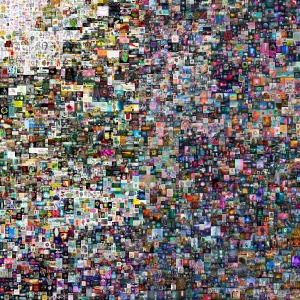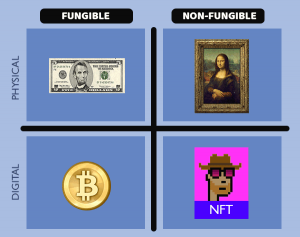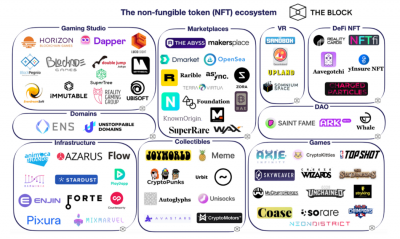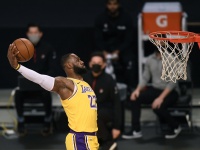NFT Art
NFT stands for Non-fungible Token, a type of token built on the Ethereum blockchain in which every token is distinct from one another.[1] Bitcoin would be an example of a fungible currency, with each Bitcoin in circulation being identical to any other Bitcoin, and one can be traded for another equally. Artists can create digital art then issue an NFT for it. A buyer can purchase the art, which is non-fungible and hence unique. [2] NFTs have created a new method for artists to distribute unique digital art.[2]
Contents
History of Auctioning Art
Prior to the creation of the NFT and NFT marketplaces, art was and still is sold in a physical setting. Global art sales generate anywhere from 60 to 70 billion dollars per year.[3] From this pool, 20% of the sales come from auctions.[3] The traditional way art gets into the market is when a collector or institution decides that they want to put their piece up. Then auction houses can work with the seller to host events to auction their piece. The top three auction companies sorted by payout are Sotheby’s, Christie’s, and Phillips, respectively.[4] Companies like these then have a team of specialists who determine the authenticity and price of the piece. [3]
History and Conception of NFT's
Beginning in 2012, the issuance of “colored” Bitcoins on the Bitcoin blockchain can be argued as the first[5] real use of NFTs in the world of blockchain. While colored Bitcoin was not cryptographically secured as unique and therefore non-fungible, colored Bitcoin is instead a set of meta-data instructions and rules which groups of users could manipulate to enforce representation[6] of some non-bitcoin asset using an arbitrary store of Bitcoin. However, the weakness of Bitcoin’s scripting language led to these groups being very niche and very, very small, as the price of these tokens had to be agreed upon by the members of the group, essentially making the security as strong as the weakest link. Colored coins gave people an idea of the power of issuing assets on the blockchain, and with this recognition, Counterparty was born. As a project it allowed for users to issue assets than for assets to be bought and sold in the Counterparty decentralized exchange, all running atop a blockchain. Various card games were established and people even began to create NFT’s of memes such as Pepe the frog. But what truly sparked the NFT movement to life was a project known as CryptoKitties.
On November 28th, 2017, an application on Ethereum known as CryptoKitties allowed users to buy and sell non-fungible tokens of (as the name implies) cats. Some kitties were rarer than others, coming in a variety of costumes and fur types, ultimately creating a market for these non-fungible tokens and later creating a bubble with some of the original kitties selling at a whopping roughly $113,000[7] . The craze around CryptoKitties died as the bubble popped, but it set to turn the gears which would eventually allow digital artist Mike Winkelmann aka “Beeple” to sell his piece “Everydays” at auction for a steep ~$69 million[8] . 2018 and onwards has been big for projects that are a part of the NFT ecosystem, CryptoKitties tuned many heads towards the value of NFT’s as part of the decentralized ecosystem, and with the recognition of that importance came about the incorporation of NFT fundamentals into the infrastructure or compatibility of a whole host of other projects seen in the graphic to the right.
Market Place
Buying
There are many different websites one can use to buy NFT art. Some of the most used websites are Nifty Gateway, SuperRare, and OpenSea. [9] Art on these websites must be purchased with Ether, the native currency of the Ethereum blockchain. Since NFTs are created on the Ethereum blockchain, ownership of each piece is now public information and is verifiable on the public ledger. [9]
Selling
NFT art is also sold by creators on these marketplaces. The creation of the art is entirely up to the artist. Artists can sell any type of art, with the only requirement being that it is digital, whether that be a PNG, GIF, WEBP, MP4, or MP3. [10] Some websites function like traditional auction houses where there is a barrier to entry. On Nifty.com, artists must apply to have their work listed, and if accepted they will take 5% + 30 cents of every secondary sale. [11] Whereas on rarible.com, anyone can instantly sell their artwork, making it more of an open market. [10] The artist has to decide how many issues of their art they want to mint. Additionally, artists can set what percentage of royalties they want on secondary sales of a piece. [10]
Notable Examples

Everydays: The First 5000 Days
As NFT art continues to become more popular, some of the major auction houses known for their sales of physical art are starting to sell digital art. Christie’s recently listed a piece of NFT art called Everydays: The First 5000 Days from the popular digital artist Mike Winkelmann, commonly known as Beeple [12]. The piece was the first NFT they had ever offered for sale and the first piece ever sold at a major auction house. A digital collage, the piece was a collection of 5000 pieces of digital art that Beeple posted online day-after-day for over thirteen years starting in 2007. [12]
Everydays: The First 5000 Days sold for over $69.3 million to Metakovan, a crypo-asset investor and the founder of Metapurse, a fund that collects NFTs. [13] The piece and Christie’s fees were all paid for entirely in Ether, the cryptocurrency that lives on the Ethereum blockchain.
The First Tweet
Twitter co-founder and CEO Jack Dorsey is auctioning off his first tweet, also the first ever tweet on the platform, as an NFT. The tweet which reads “just setting up my twttr” and was published on March 21, 2006 is being sold on the digital platform Valuables which allows people to buy and sell tweets autographed by their original creators. [14]
The current highest bid is $2.5 million by Sina Estavi, CEO of Bridge Oracle. The auction closes on March 21, 2021, the fifteenth anniversary of the tweet. Dorsey has pledged that he will immediately convert all proceeds into the cryptocurrency bitcoin and donate it to Give Directly’s Africa Covid Response program. The final auction winner will receive a digital certificate of the tweet, and the tweet will remain on the Twitter platform for everyone to view. [15]
Ethical Implications
Energy use
NFTs live on the Ethereum blockchain, and minting NFTs on the network requires servers, which consumes energy and produces carbon emissions. French Artist, Joanie Lemercier previously sold some of his work on Nifty Gateway and later found out that the sale of his work used 8.7 megawatt-hours of energy, equivalent to two years of energy use in his apartment. [16] From smart-energy.com “Renewables powers almost 40% of proof-of-work cryptocurrency mining”. [17] A large portion of crypto mining still relies on non-renewable energy. Yet, even if crypto was all renewable, cities like Missoula, Montana are stopping crypto mining as it is creating more competition for renewable energy and thus pushing away other big energy users to rely on non-renewable sources.[16]
Security
As NFTs are digital art anyone can copy art and sell it as their own. Recently artist RJ Palmer had his artwork copied and sold as an NFT, as someone just downloaded pictures of his artwork and sold them as their own.[18] So if the artist puts out art on the internet for free then anyone can claim it as their own. The artist needs to be the first to issue an NFT, producing more overhead for the creator. Supporters say that NFT art is safer than purchasing traditional art. Gregory Barber from a blockchain specialist from the University of Columbia and Wired said “with an NFT, the owner buys a verified token providing digital evidence that the art is theirs—a bit like an artist’s signature”. [16]So now you can verify all the past owners of a piece of art on the blockchain’s public domain. However, reports show that the blockchain is not entirely secure yet. A report from the MIT Technology Review claims that nearly $2 billion dollars worth of cryptocurrencies has been hacked. [19] This poses a concern for collectors who fear that their ownership of their art may be hacked.
Additionally, accounts containing art can be compromised in traditional ways, such as a password being stolen. Recent account breaches have occurred in which the marketplace Nifty Gateway was accessed by credential-stealing thieves. [20]
Artist control
Artists producing NFT art can set royalties for secondary sales of their original work. In the past, once ownership transferred, the artists no longer had rights over their art. Even after the artist dies, their family can receive commissions on their work. Vincent Van Gogh sold his first painting for 400 francs, and it was not until after he died that his paintings were worth millions.[21] Artists do not have to go through auction houses anymore to sell their artwork. This elimates the chance of rejection before a piece is even available to the public, as auction houses like Christie’s do not have to accept your art.[22] Additionally, artists can have the power to set the price of their art and not have it set by auction houses.
References
- ↑ Mitchell, Clark. "NFTs, explained" (2021, March 11). The Verge. Retrieved March 12, 2021.
- ↑ 2.0 2.1 Josie, Thaddeus-Johns. "What Are NFTs, Anyway? One Just Sold for $69 Million. (2021, March 11). The New York Times. Retrieved March 11, 2021.
- ↑ 3.0 3.1 3.2 Steven, Murphy. "Art explained: How do art auctions really work?" (2018, August 30). CNN . Retrieved March 11, 2021.
- ↑ Thierry, Ehrmann"The best auction houses". Art Price. Retrieved March 11, 2021
- ↑ Steinwold, Andrew"The History of Non-Fungible Tokens (NFT's)". Colored Bitcoins. Retrieved March 18, 2021
- ↑ Bradburry, Danny"Colored coins paint sophisticated future for Bitcoin". Colored Bitcoins Metadata Scheme. Retrieved March 18, 2021
- ↑ Tepper, Fitz"People have spent over $1M buying virtual cats on the Ethereum blockchain". CryptoKitties information. Retrieved March 18, 2021
- ↑ Delingpole, Charles"What are the money-laundering risks with non-fungible tokens (“NFT’s”) and Decentralized Finance (“DeFI”)?". Beeple "Everydays" Cost. Retrieved March 18, 2021
- ↑ 9.0 9.1 Stan, Horaczek "NFTs are blowing up the digital art and collectibles worlds. Here’s how they work."(2021, March 10) Popular Science . Retrieved March 11, 2021.
- ↑ 10.0 10.1 10.2 "Create single collectible" Rarible . Retrieved March 11, 2021.
- ↑ "Work With Us to Create and Sell your Own Nifties" Gemini. Retrieved March 11, 2021.
- ↑ 12.0 12.1 “Beeple's Masterwork: the First Purely Digital Artwork Offered at Christie's” Beeple: A Visionary Digital Artist at the Forefront of NFTs | Christie's, Christies, 11 Mar. 2021, www.christies.com/features/Monumental-collage-by-Beeple-is-first-purely-digital-artwork-NFT-to-come-to-auction-11510-7.aspx.
- ↑ Palumbo, Jacqui, and Amy Woodyatt. “Buyer behind $69m Record-Breaking Art Sale Revealed.” CNN, Cable News Network, 13 Mar. 2021, www.cnn.com/style/article/beeple-first-nft-artwork-at-auction-sale-buyer-intl-scli/index.html.
- ↑ Goodwin, Jazmin. “You Can Buy the First-Ever Tweet. The Current Bid: $2.5 Million.” CNN, Cable News Network, 7 Mar. 2021, www.cnn.com/2021/03/07/tech/jack-dorsey-nft-twitter/index.html.
- ↑ Peters, Jay. “Jack Dorsey's First Tweet May Fetch $2.5 Million, and He'll Donate the NFTy Proceeds to Charity.” The Verge, The Verge, 9 Mar. 2021, www.theverge.com/2021/3/9/22321464/jack-dorsey-nft-tweet-auction-bitcoin-donate-charity.
- ↑ 16.0 16.1 16.2 Gregory, Barber. "NFTs Are Hot. So Is Their Effect on the Earth’s Climate" (2021, March 06). . Wired. Retrieved March 12, 2021.
- ↑ Johnathan, Jones. "Renewables powers almost 40% of proof-of-work cryptocurrency mining" (2020, September 29). . smart-energy. Retrieved March 12, 2021.
- ↑ Anna, Lee. "Everything You Need to Know About NFTs—the Crypto Art Selling For Millions" (2021, March 11). esquire. Retrieved March 12, 2021.
- ↑ Mike, Orcutt. "Once hailed as unhackable, blockchains are now getting hacked" (2019, February 19). MIT Technology Review. Retrieved March 12, 2021.
- ↑ Grace, Kay. [https://www.businessinsider.com/stolen-nfts-on-nifty-gateway-reports-nft-art-marketplace-2021-3/
- ↑ Erik, Velde. "WAS 'THE RED VINEYARD’ REALLY THE ONLY PAINTING VAN GOGH EVER SOLD?" (2020, February 13). . Van Gogh Studio. Retrieved March 12, 2021.
- ↑ "Selling at Christie's" . Christies. Retrieved March 12, 2021.


